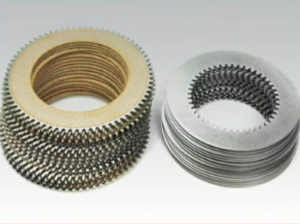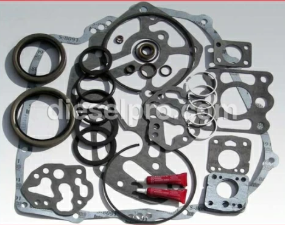
Parts catalog for Twin Disc MG50590A Marine Transmissions
Overhaul Plate Kit For Twin Disc MG5090A Marine Transmission
Gasket Kits For Twin Disc MG5090A Marine Transmission
Introduction: Diagnosing Problems in the MG-5090A Marine Transmission
The Twin Disc MG-5090A marine gear is a highly reliable reverse and reduction transmission used in commercial vessels, patrol boats, and recreational craft worldwide. Like any precision mechanical system, it is subject to wear, oil-related problems, and external control issues over time. Fortunately, the MG-5090A is designed to be diagnostic-friendly, allowing marine technicians and vessel operators to pinpoint most problems quickly—if they know what to look for.
This comprehensive troubleshooting guide analyzes the most common symptoms, explores their possible root causes, and outlines the corrective actions necessary to restore smooth, dependable performance. Each section is supported by practical testing steps, repair tips, and advice on when to consider professional assistance or transmission replacement.
Whether you’re dockside with a slipping transmission or facing a high-load overheating issue, this resource can help get your MG-5090A back in action quickly.
1. Slipping in Gear

Symptom: Engine revs increase, but boat speed does not. The propeller feels like it loses bite.
Possible Causes:
- Low clutch pressure due to pump wear, internal leaks, or blocked hydraulic passage
- Worn or burned clutch discs with insufficient friction material
- Incorrect shift linkage or actuator not fully engaging the clutch valve
- Contaminated or broken-down oil reduces clutch engagement effectiveness
Diagnostic Steps:
- Measure clutch engagement pressure with a hydraulic gauge at the forward or reverse test port
- Inspect oil color and smell: Burnt odor = clutch overheating
- Use a borescope or remove the inspection cover to inspect the clutch stack visually
- Check shift linkage travel or electronic actuator function (EC300, etc.)
Corrective Actions:
- If hydraulic pressure is below 250 PSI:
- Check oil filter
- Inspect oil pump and pressure regulator
- Verify no air is trapped in the system
- If clutch pack is worn or scorched:
- Rebuild the clutch using a kit with new friction discs and steel plates
- Replace piston seals and return springs
- Confirm proper piston movement during reassembly
- If mechanical linkage is misaligned:
- Adjust cable end fittings and ensure lever reaches detent position
- Lubricate all linkage points
- Replace oil with clean, Twin Disc-spec SAE 30 transmission oil
2. Harsh or Jerky Shifting
Symptom: Abrupt engagement or jolt when shifting between neutral and gear
Possible Causes:
- Sticky or dirty shift valve inside control block
- Hydraulic oil contaminated with sludge or metal particles
- Actuator delay or overshoot in electronic control system
- Improper cable tension or control arm misalignment
Diagnostic Steps:
- Inspect oil quality—look for milky, dark, or debris-laden fluid
- Cycle the shift lever manually and observe valve movement
- If electronic, plug into control module (EC300) and run diagnostics
- Remove and inspect control valve spool for sticking or galling
Corrective Actions:
- Flush and replace transmission oil
- Include new filter and clean oil cooler
- Include new filter and clean oil cooler
- Remove shift valve assembly
- Clean with solvent and compressed air
- Reinstall with new seals if available
- Calibrate electronic control systems
- Reset shift delay parameters via EC300 or compatible controller
- Replace sticky linkage bushings or cable mounts
3. No Response When Shifted into Gear
Symptom: Lever moves but transmission remains in neutral or doesn’t engage propeller
Possible Causes:
- Control linkage disconnected or misaligned
- Low or empty oil level
- Actuator failure in electronic systems
- Broken internal clutch piston seal or failed spring pack
Diagnostic Steps:
- Verify oil level using dipstick (engine idling in neutral)
- Manually shift the transmission at the clutch lever and listen for engagement
- Check actuator movement (electronic) for full travel
- Test hydraulic pressure at forward/reverse ports
Corrective Actions:
- If oil is low:
- Top off with correct transmission oil
- Inspect for leaks at seals, drain plugs, and cooler hoses
- If cable is broken or actuator fails:
- Replace mechanical cable with marine-grade stainless type
- Replace EC300 actuator or calibrate sensor feedback
- If no pressure at test ports:
- Check for airlock or failed oil pump
- Inspect for blocked pressure path or stuck spool valve
- If piston seals are blown:
- Disassemble clutch housing
- Replace seals, springs, and clutch stack if contaminated
4. Noise Under Load
Symptom: Whining, grinding, or knocking when transmission is under forward or reverse power
Possible Causes:
- Worn or damaged gears (input, output, planetary)
- Failed or pitted bearings
- Improper gear lash or shaft alignment
- Debris or contamination inside housing
Diagnostic Steps:
- Run engine at different loads and listen to gearbox
- Use stethoscope or sound probe to isolate noise source
- Drain oil and inspect for metal fragments
- Remove inspection cover and check gear teeth visually
Corrective Actions:
- If gears show pitting or scoring:
- Replace individual gear or complete gearset
- Match gear pairing to maintain alignment and contact pattern
- If bearings are noisy or loose:
- Remove and press in new roller or needle bearings
- Inspect shaft journals for scoring
- Use proper shimming and torque specs during reassembly
- Consider full rebuild or replacement unit if damage is extensive
5. Overheating Transmission
Symptom: Transmission oil temperature rises above 190°F during normal operation
Possible Causes:
- Clogged or fouled oil cooler
- Low oil level or poor oil quality
- Clutch slippage under load
- Restriction in oil flow (filter or passage)
Diagnostic Steps:
- Use infrared thermometer to measure cooler and housing temps
- Check for oil flow at cooler inlet/outlet
- Inspect oil cooler for marine growth or scale buildup
- Check clutch pressure for signs of slippage
Corrective Actions:
- Flush and descale the oil cooler
- Backflush with descaler and fresh water
- Replace if pressure test fails
- Top off or replace oil
- Use SAE 30 transmission oil with high heat tolerance
- Use SAE 30 transmission oil with high heat tolerance
- Inspect filter and replace if clogged
- Install new filter from Diesel Pro Power
- Install new filter from Diesel Pro Power
- Inspect and rebuild clutch if slipping occurs
- Heat during slippage degrades plates and oil alike
- Heat during slippage degrades plates and oil alike
Additional Issues and Corrective Actions
6. Leaking Seals or Gaskets

Cause:
- Worn shaft seals
- Improperly torqued covers
- Old or reused gaskets
- Cracked housing
Solution:
- Replace all seals during service
- Apply sealant sparingly where specified
- Torque bolts in crisscross pattern
- Replace cracked components or use reman unit
7. Transmission Stuck in Gear
Cause:
-
Seized control valve
- Detent mechanism failure
- Debris in hydraulic circuit
Solution:
- Disassemble valve block and clean
- Replace detent spring and ball
- Flush hydraulic oil and test pressure
8. Shudder on Engagement
Cause:
- Warped clutch plates
- Glazed friction material
- Low pressure spike
- Air in oil
Solution:
- Replace friction and steel plates
- Check plate stack height
- Bleed air from system
- Use fresh oil with proper viscosity
9. Noisy Start-Up After Rebuild
Cause:
- Dry bearings or improper preload
- Loose hardware or incorrect reassembly
- Clutch misalignment
Solution:
- Re-check torque settings
- Use assembly lube
- Inspect for missing shims or reverse gear misalignment
10. Control Lever Feels Loose or Slack
Cause:
- Worn linkage bushings
- Detached control cable
- Failed actuator
Solution:
- Replace bushings and adjust end fittings
- Calibrate EC300 system
- Lubricate mechanical joints
Preventive Maintenance to Avoid Common Problems
Routine Checks:
| Task | Interval |
| Check oil level and clarity | Every 50 hours |
| Inspect shift linkage | Monthly |
| Flush oil and replace filter | Every 1,000 hours |
| Cooler flushing | Annually |
| Clutch pressure test | Every 1,000 hours |
| Full teardown inspection | Every 3,000 hours |
Tips to Prevent Failures:
- Use only approved SAE 30 marine transmission oil
- Do not idle long periods in gear
- Install zincs and strainers to protect oil cooler
- Log all maintenance and oil changes
- Replace shift cables every 3–5 years
- Use only OEM-quality or Diesel Pro Power aftermarket parts
When to Replace Instead of Repair
Consider ordering a remanufactured MG-5090A if:
- Multiple internal components show wear
- Gear case is cracked or warped
- Transmission has history of repeated failures
- Downtime is unacceptable
Diesel Pro Power offers:
- Fully rebuilt MG-5090A units
- Pre-tested under load
- Warranty and fast global delivery
Summary: Identify Symptoms Early to Keep Your MG-5090A in Top Shape
The Twin Disc MG-5090A is a workhorse transmission, but even the toughest marine gear systems experience wear, oil-related degradation, or control issues over time. Understanding how to recognize and respond to early warning signs—like slipping, overheating, or odd noises—can prevent costly breakdowns, unplanned haul-outs, and extended downtime.
This troubleshooting guide provides a practical roadmap for resolving common problems quickly and effectively. With proper diagnostics, use of high-quality replacement parts, and professional support when needed, your MG-5090A can deliver many more hours of dependable propulsion.
Troubleshooting Summary Table
Symptom |
Possible Cause |
Corrective Action |
| Slipping in gear | Low pressure, worn clutches | Test pressure, rebuild clutch |
| Harsh shifting | Dirty oil, sticky valve | Flush oil, clean/replace control valve |
| No response in gear | Control fault, low oil | Check linkage, actuator, top off oil |
| Noise under load | Worn gears or bearings | Inspect, replace with rebuild kit |
| Overheating | Dirty cooler, slipping clutch | Clean cooler, test pressure, replace oil |
| Leaking seals | Aged or damaged components | Replace gaskets, seals, or housing |
| Shuddering engagement | Warped clutch plates | Replace clutch stack, confirm pressure |
| Stuck in gear | Valve or detent failure | Clean or replace valve block, rebuild detent |

Overhaul Plate Kit For Twin Disc MG5090A Marine Transmission
Gasket Kits For Twin Disc MG5090A Marine Transmission
Videos About Twin Disc Transmissions
6 Reasons Your Twin Disc Transmission Has Low Oil Pressure
7 Reasons Your Twin Disc Transmission Is Overheating
3 Reasons Your Clutch Plates in Your Twin Disc Transmission Are Making Excessive Noise
Bull Gear On A Twin Disc Transmission
Rebuilt Twin Disc Transmissions



 Free US Calls: 1-888-433-4735
Free US Calls: 1-888-433-4735 International: 305-545-5588
International: 305-545-5588